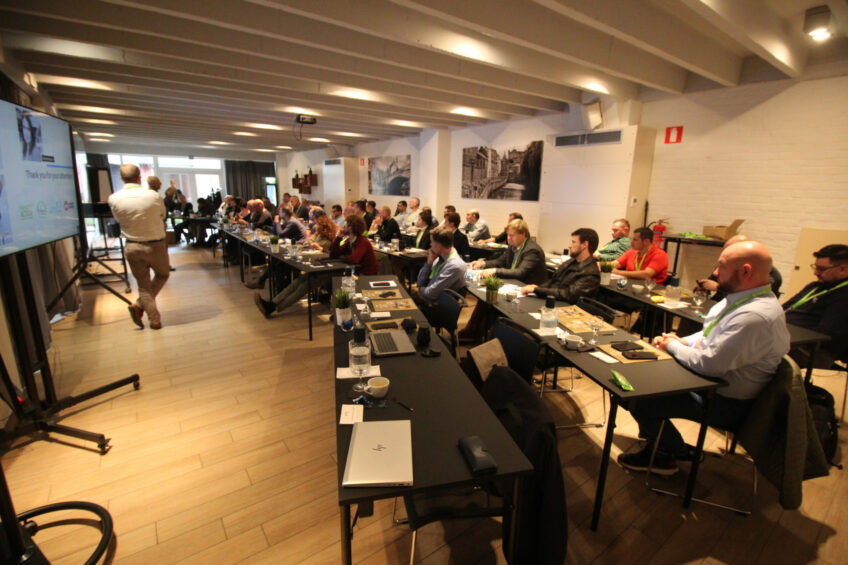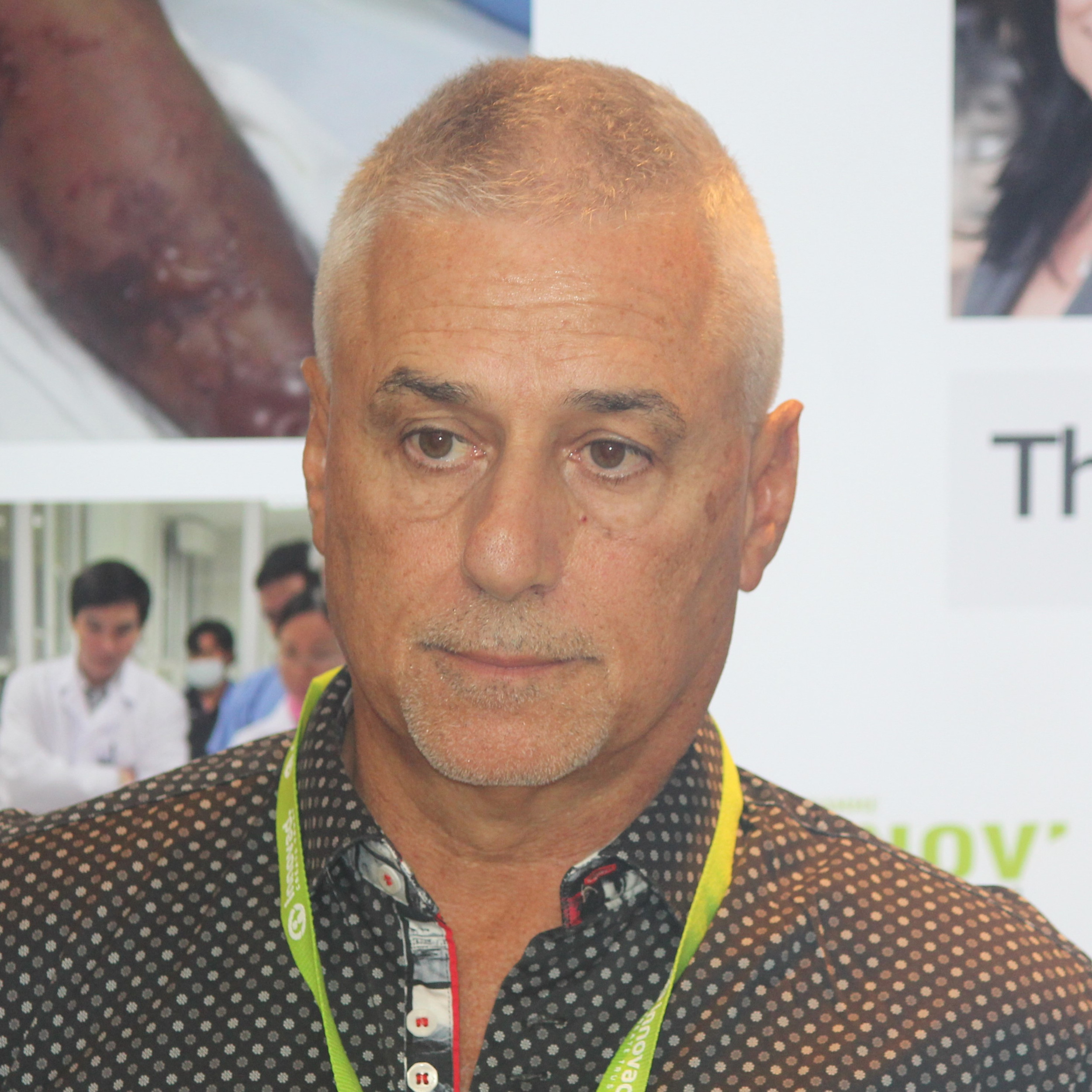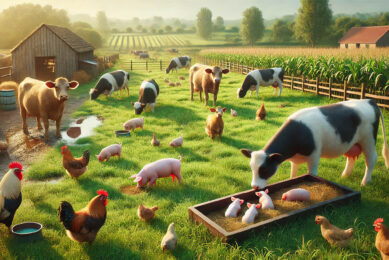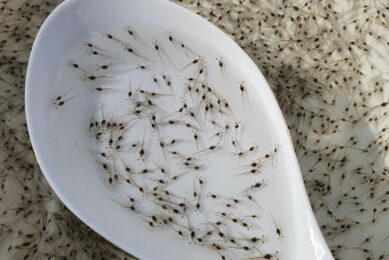Review: Lessons about the gut in theory and practice

Many events in the swine industry these days revolve around gut health. Now how to make sure that an international event makes a permanent impression on delegates? One way to do so is by not only talking about the pig gut, but also taking them on a practical mission in the necropsy room.
In front of veterinarian Bruno Muro, on a spotless white table, is a dead weaner pig. Barely larger than a cat, the ice cold and motionless animal must have died less than 24 hours ago. Muro is holding a large knife, whilst his hands, tucked in green plastic gloves are bathing in light and a camera follows each of his moves as he speaks.
The vet explains some of the steps how to do a necropsy with piglets that suffered a sudden death.* First, a check is needed if there had been any neurological defects – and he slides off the animal’s head almost completely, inspecting the neck. Next, it is time to open up the chest and belly – with a few quick moves he cuts through the tendons at all four legs so they give way for an easier look inside. What follows is much like a reverse jigsaw. Lungs, heart, liver, pancreas, spleen come out and are being examined, cut open and observed. The animal has a full stomach in combination with an empty gut – a first educated guess towards cause of death would be oedema disease, caused by E. coli, Muro says. Further lab tests will have to follow to check that hypothesis.

Daily routine
In PoulPharm, close to Roeselare in Belgium, the above is daily routine. Trained veterinarians do this type of research very often, it takes them ten to 20 minutes per animal. But on this day in October 2024, a group of 53 swine professionals from various continents try to catch a glimpse of the animal whose body parts are now spread out across the table. Apart from several vets, the group contains nutritionists and one journalist.
For those without a veterinary degree, necropsies may not be day-to-day business. Yet, they are vital in order to understand why piglets live, eat and thrive – or suffer, starve and perish. The question “what actually happens inside a pig?” was therefore key at the first-ever Porcine Health & Nutrition Masterclass, organised by feed additive manufacturer Innovad. After having organised various events like these for the poultry industry, the company wanted to bring together swine vets and nutritionists in a similar fashion.
So apart from doing necropsies and a lab visit, the 3-day event in Belgium, revolved around learning. Several technical, high-quality speakers presented uninterruptedly for 75 to 90 minutes uninterruptedly, followed by thorough question and answer sessions.

A journey through the gut
Emeritus Prof Dr Richard Ducatelle, attached to Ghent University, kicked of the event, which mostly took place in Ghent. In an entertaining style, his explained where various challenges could take place inside a pig’s gastro-intestinal tract (GIT). A recurring picture showed the bacteria density in the GIT. This started with the stomach, then the caecum, the jejunum, the ileum etc. Each part of the GIT has its own characteristics, its own function, its own bacteria density and also its own microbiome, he said.
Acids in the stomach tend to make bacteria groggy, Prof Ducatelle explained. That is useful because then they will not compete for the nutrients when they need to be taken up by the host animal in the small intestine. After all, he said, most of the nutrients are absorbed in the small intestines. The colon, he called the intestinal fermentation vessel. Ideally, butyrate producing bacteria should dominate that area.

A deep dive into S. suis
Streptococcus suis was the topic of the talk of the next speaker, Prof Marcelo Gottschalk, attached to the University of Montréal in Canada. He introduced the pathogen as one giving a headache to experts. After all, is the bacteria pathogenic? He explained that quite often the pathogen is colonising a tissue once it was already on its way to die because of another pathogen. In that case, a heavy load of bacteria is present, but does that imply that this was the causative agent of the disease? Or is it simply opportunistic?
He went on to describe about a lot of research is being done in Canada to figure out whether that would be working best by vaccinating the sows, the piglets, or both? Which adjuvant works best? And does vaccination not interfere with maternal antibodies? Multiple doses are best, he said, and the use of a strong adjuvant is recommended. Also, he focused on the role of animal’s inflammatory status on the S. suis outbreaks.

Mycotoxin masterclass
Prof Dominiek Maes of Ghent University kicked off the second day. He zoomed in on mycotoxins in animal nutrition and explained how to classify them. He also gave an insight into the world of emerging mycotoxins – after all, as detection technologies improve, awareness is growing about mycotoxins hitherto unknown. Amongst the emerging mycotoxins he mentioned e.g. enniatin, beauvericin and tenuazonic acid.

Emerging mycotoxins came back in the next presentation by Innovad’s Dr Arnau Vidal, global technical manager for toxins and stress. He explained about “biomonitoring,” a method of mycotoxin detection by doing blood tests, offered by Innovad and developed in cooperation with Ghent University. The method was introduced as having advantages over checking batches of feed, in which contaminations may be under- or overlooked. Checking blood levels, however, would provide much more accurate outcomes what mycotoxin problems are prevalent – and therefore can help adjusting the mitigation strategy, he said.
Zinc oxide, gut health and water
The last day started with a presentation of Dan Bussières, nutritionist of Groupe Cerès, Canada, who spoke about the Canadian road to reducing levels of zinc oxide in pig nutrition. He discussed various useful strategies and those that are already applied in practice.
Then independent animal nutrition consultant Dr Jannes Doppenberg took to the stage. Achieving piglet health, without the usage of antibiotics or zinc oxide, will have to go through a healthy microbiome, which starts with the sow, he said. Attention for sow nutrition should be complemented, by a high quality pre-starter piglet feed, low in crude protein and energy, but with enough and well balanced fibres .
Dr Milena Sevastiyanova, global technical lead of Innovad, closed off the event with her presentation. She focused on how drinking water quality influences effectiveness of the medication and could lead to digestive disorders and performance issues. She said that animals have several mechanisms to keep the acid-base homeostasis in the intestines. Extreme and long term water and feed acidification will lead to disturbances in enzyme functioning, digestion of the nutrients and acid-base balance.
Learning experience
The presentations formed a decent basis of take-home messages. The practical experience from the necropsy room reinforced all of them. All participants saw that severe gastro-intestinal issues preceded the sudden deaths of these pigs, for which the presumptive diagnosis was S. suis.
Undoubtedly the best example of that happened when one of the participating teams in the necropsy workshop stumbled onto an obvious cause of death in one of the deceased piglets: a stomach ulcer. What followed was rumour of excitement, as all 53 present gathered around the carcass to catch a glimpse. For the pig, the red patch in the stomach wall must have been a source of agony. For those present, however, it was a never-ending learning experience.
* This paragraph serves as a reflection of the author’s experience and was included to set the scene. The paragraph should not be read as an attempt to be 100% complete or accurate.











